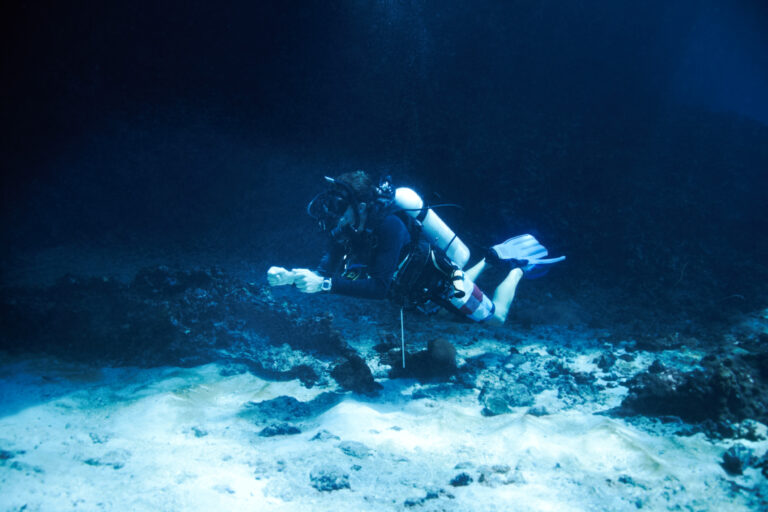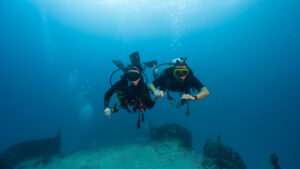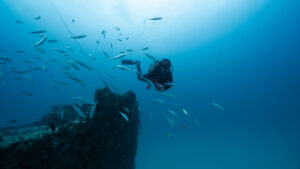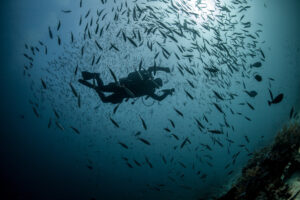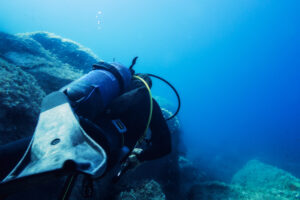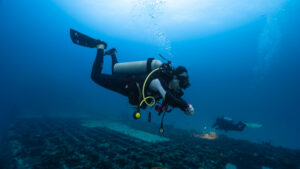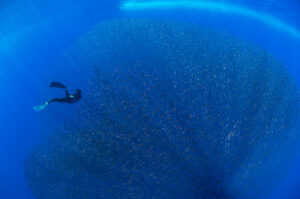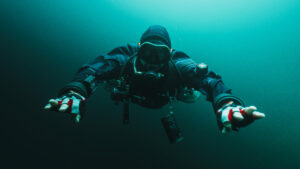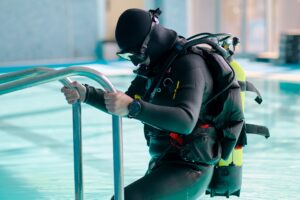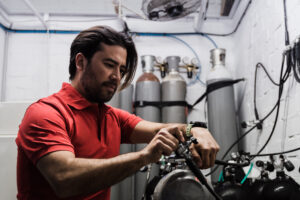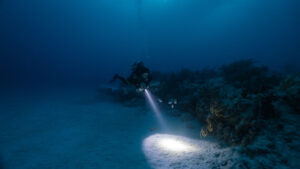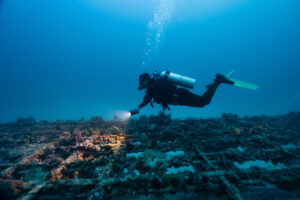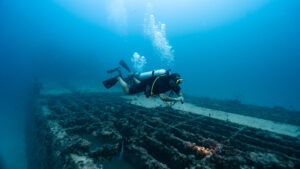What is Saturation?
Saturation, in the context of scuba diving, refers to the state where body tissues have absorbed the maximum amount of inert gas they can hold at a given pressure. This concept is crucial for divers, especially those engaging in deep or prolonged dives. Understanding saturation helps divers manage their exposure to high-pressure environments and ensures they follow appropriate decompression protocols to avoid decompression sickness (DCS). This article delves into the basic principles of saturation, the specifics of saturation diving, its physiological implications, decompression strategies, technological aspects, and safety protocols.
Basic Principles of Saturation
Saturation in scuba diving relates to the solubility of gases in body tissues under increased pressure, primarily governed by Henry’s Law. According to this law, the amount of gas that dissolves in a liquid is directly proportional to the partial pressure of that gas above the liquid. When a diver descends, the pressure increases, causing more inert gases like nitrogen to dissolve into the body’s tissues. As long as the diver remains at a certain depth, the tissues will continue to absorb gas until they reach saturation, meaning they can hold no more gas at that specific pressure.
The process of gas absorption and saturation is gradual and depends on the duration of the dive and the depth. The deeper and longer a diver stays underwater, the more inert gas is absorbed. This understanding is crucial for determining safe dive times and depths, as well as planning decompression stops during the ascent. Saturation is not just a factor for nitrogen; it applies to other gases used in breathing mixes, such as helium in technical diving. The solubility and saturation rates vary for different gases, influencing the dive planning process.
While saturation is a natural process, managing it is vital to prevent decompression sickness. When divers ascend too quickly, the reduced pressure can cause dissolved gases to form bubbles in tissues and the bloodstream, leading to potentially serious health issues. Proper dive planning and adherence to decompression protocols are essential to avoid these risks. By understanding and managing saturation, divers can enjoy underwater activities safely and effectively.
Saturation Diving: An Overview
Saturation diving is a technique used primarily in commercial and scientific diving operations where divers work at great depths for extended periods. Unlike conventional diving, where divers must return to the surface and undergo decompression after each dive, saturation diving allows divers to stay at depth for prolonged periods and undergo decompression only once at the end of their mission. This method significantly increases efficiency and reduces the risk of decompression sickness from repeated exposure to pressure changes.
In saturation diving, divers live in a pressurized environment, such as a saturation habitat or diving bell, which is maintained at the same pressure as their working depth. This environment enables them to spend days or even weeks underwater without the need for multiple decompression cycles. When their task is completed, they undergo a single, controlled decompression process in a decompression chamber, which can take several days to weeks depending on the depth and duration of the dive.
Saturation diving is commonly used in offshore oil and gas industries, underwater construction, and scientific research. It allows divers to perform complex tasks at depths of up to 300 meters (984 feet) or more, where traditional scuba diving would be impractical or unsafe. The ability to remain at depth for extended periods is particularly advantageous in these fields, as it maximizes productivity and minimizes the physical strain and risks associated with frequent decompression.
The unique conditions of saturation diving require specialized training and equipment. Divers must undergo rigorous physical and psychological evaluations to ensure they can handle the prolonged confinement and high-pressure environment. The specialized equipment used in saturation diving, including pressurized habitats and diving bells, is designed to support the divers’ needs and maintain a safe and stable living and working environment under extreme conditions.
Physiological Implications of Saturation
The human body undergoes significant physiological changes when exposed to the high-pressure environments encountered in saturation diving. One of the primary concerns is the absorption of inert gases, such as nitrogen and helium, into body tissues. As pressure increases, these gases dissolve more readily in tissues, leading to saturation. The rate at which gases are absorbed and reach saturation varies depending on the depth and the type of gas.
Nitrogen, the most common inert gas encountered in diving, can have narcotic effects at high pressures, known as nitrogen narcosis. This condition impairs cognitive and motor functions, posing a risk to divers. Helium is often used in breathing mixes for deep dives to mitigate these effects, as it has lower solubility and does not cause narcosis. However, helium presents other challenges, such as increased heat loss and voice distortion, which must be managed carefully.
Another physiological concern in saturation diving is the risk of decompression sickness (DCS). Prolonged exposure to high-pressure environments increases the amount of dissolved gas in tissues, and rapid decompression can cause these gases to form bubbles. Bubbles can obstruct blood flow and damage tissues, leading to symptoms ranging from joint pain and rashes to severe neurological and cardiovascular issues. Controlled decompression procedures are critical to allow the safe elimination of dissolved gases from the body.
The long-term effects of saturation diving on the human body are still not fully understood, but there are known risks associated with extended exposure to high pressure. These include potential damage to lung tissues, bone necrosis, and other health issues. Continuous monitoring of divers’ health and advancements in diving medicine aim to mitigate these risks. Despite these challenges, saturation diving remains a valuable technique for deep-sea operations, providing unparalleled access to underwater environments while emphasizing the importance of safety and health management.
Decompression in Saturation Diving
Decompression is a critical aspect of saturation diving, as it involves safely transitioning divers from high-pressure environments to surface pressure. The decompression process in saturation diving is more complex and prolonged than in conventional diving due to the extended exposure to high pressures and the greater amount of dissolved inert gases in the divers’ tissues.
The decompression process begins once the saturation dive is completed, and it involves transferring the divers to a decompression chamber. This chamber is a controlled environment where pressure can be gradually reduced in a carefully monitored manner. The decompression schedule is meticulously planned based on the depth and duration of the dive, as well as the gas mixture used. The goal is to allow inert gases to be eliminated from the body tissues without forming harmful bubbles.
In a typical saturation decompression procedure, the pressure is reduced slowly over several days to weeks, depending on the specifics of the dive. This gradual reduction helps prevent decompression sickness by allowing the dissolved gases to be safely released from the tissues and exhaled. The decompression chamber provides a stable and safe environment for divers during this process, with medical support available if needed.
To facilitate decompression, divers often breathe gas mixtures with reduced nitrogen content or increased oxygen levels. Oxygen accelerates the elimination of inert gases and reduces the risk of nitrogen narcosis and decompression sickness. Heliox, a mixture of helium and oxygen, is commonly used in deep saturation diving due to helium’s lower solubility and narcotic effects compared to nitrogen.
The success of decompression procedures in saturation diving relies on meticulous planning, monitoring, and adherence to established protocols. Divers’ health and safety are of utmost importance, and the decompression process is supervised by trained medical personnel and dive supervisors. Advances in decompression theory and technology continue to improve the safety and efficiency of saturation diving operations, allowing divers to undertake complex underwater tasks with reduced risk.
Technological and Equipment Aspects
Saturation diving requires specialized technology and equipment to support divers in high-pressure underwater environments. This technology ensures that divers can live and work safely at great depths for extended periods. One of the key components of saturation diving is the saturation habitat, a pressurized living environment that maintains the same pressure as the working depth.
Saturation habitats, often referred to as diving bells or chambers, are equipped with life support systems to provide a stable and safe environment for divers. These habitats include sleeping quarters, eating areas, and workspaces, all designed to accommodate the divers’ needs while maintaining the required pressure. The habitats are connected to the surface by umbilicals, which supply breathing gas, power, and communication links.
Another crucial piece of equipment in saturation diving is the diving bell, which transports divers between the habitat and the work site. The diving bell is also pressurized and can be lowered to the required depth, allowing divers to exit and perform their tasks. The bell provides a safe and controlled environment for the divers during their descent and ascent, minimizing the risk of decompression sickness.
Breathing gas mixtures are another important aspect of saturation diving technology. Depending on the depth and duration of the dive, different gas mixtures are used to manage the physiological effects of high pressure. Heliox, a mixture of helium and oxygen, is commonly used for deep dives to reduce the risk of nitrogen narcosis and improve safety. The gas mixtures are carefully monitored and adjusted to ensure the divers’ well-being.
In addition to life support and transport systems, saturation diving operations rely on advanced monitoring and communication technology. Divers’ health and environmental conditions are continuously monitored to detect any signs of distress or equipment malfunction. Communication systems ensure that divers can maintain contact with surface support teams, enabling coordinated and efficient operations.
The technology and equipment used in saturation diving are constantly evolving to improve safety and efficiency. Innovations in materials, design, and life support systems continue to enhance the capabilities of saturation diving, allowing divers to undertake increasingly complex and challenging underwater tasks. These advancements not only expand the possibilities for commercial and scientific diving but also ensure that divers can perform their work with the highest standards of safety and health.
Safety Protocols and Challenges
Safety is a paramount concern in saturation diving, given the extreme conditions and potential risks involved. Rigorous safety protocols and procedures are in place to protect divers and ensure successful operations. These protocols cover various aspects of saturation diving, from pre-dive preparations to emergency response plans.
Before embarking on a saturation diving mission, divers undergo thorough medical examinations to assess their fitness for extended exposure to high pressure. Psychological evaluations are also conducted to
ensure that divers can cope with the isolation and confinement of the pressurized habitat. Training programs provide divers with the necessary skills and knowledge to operate safely in these environments, including emergency procedures and use of specialized equipment.
During the dive, continuous monitoring of divers’ health and environmental conditions is essential. Life support systems in the saturation habitat and diving bell are regularly checked and maintained to ensure they function correctly. Divers’ vital signs, such as heart rate and breathing patterns, are monitored to detect any signs of distress or potential health issues. Any anomalies are addressed immediately to prevent complications.
Emergency response plans are a critical component of saturation diving safety protocols. These plans outline procedures for various scenarios, such as equipment failure, medical emergencies, and environmental hazards. Divers and surface support teams are trained to respond quickly and effectively to emergencies, minimizing the risks and ensuring the safety of all personnel involved.
Despite the comprehensive safety measures, saturation diving presents inherent challenges and risks. Prolonged exposure to high pressure can lead to physiological issues, such as bone necrosis and lung damage. The confined and isolated environment of the pressurized habitat can also impact divers’ mental health, leading to stress and anxiety. Continuous monitoring, support, and advancements in diving medicine help manage these risks, but they remain a consideration for all saturation diving operations.
Technological advancements and strict adherence to safety protocols have made saturation diving a safer and more efficient method for underwater work. However, the challenges and risks associated with this technique highlight the importance of ongoing research, training, and development to ensure the well-being of divers. By prioritizing safety and health, the diving industry continues to push the boundaries of what is possible in underwater exploration and commercial activities.
Key Takeaways
Understanding saturation in scuba diving is crucial for managing the risks associated with deep and prolonged underwater exposure. The principles of gas absorption, the specifics of saturation diving, the physiological implications, and the importance of controlled decompression all play vital roles in ensuring diver safety. Advances in technology and strict safety protocols continue to improve the efficiency and safety of saturation diving, allowing divers to undertake complex underwater tasks while minimizing risks.

